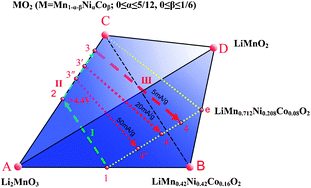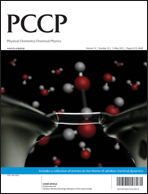The ‘composite’ layered materials for lithium-ion batteries have recently attracted great attention owing to their large discharge capacities. Here, the 0.5Li2MnO3·0.5LiMn0.42Ni0.42Co0.16O2 ‘composite’ layered manganese-rich material is prepared and characterized by the synchrotron X-ray powder diffraction (SXPD). The relationship between its electrochemical performance and its ‘composite’ components, the Li2MnO3 phase activation process during cycling and the cycle stability of this material at room temperature are elucidated based on its kinetic controlled electrochemical properties, dQ/dV curves and Raman scattering spectroscopies associated with different initial charge–discharge current densities (5 mA g−1, 20 mA g−1 and 50 mA g−1), cut-off voltages (4.6 V and 4.8 V) and cycle numbers (50 cycles and 150 cycles). Furthermore, its reaction pathways are tracked via a firstly introduced integrated compositional phase diagram of four components, Li2MnO3, LiMn0.42Ni0.42Co0.16O2, MO2 (M = Mn1−α−βNiαCoβ; 0 ≤ α ≤ 5/12, 0 ≤ β ≤ 1/6) and LiMnO2, which turns out to be a very important guiding tool for understanding and utilizing this ‘composite’ material.

You have access to this article
 Please wait while we load your content...
Something went wrong. Try again?
Please wait while we load your content...
Something went wrong. Try again?


 Please wait while we load your content...
Please wait while we load your content...